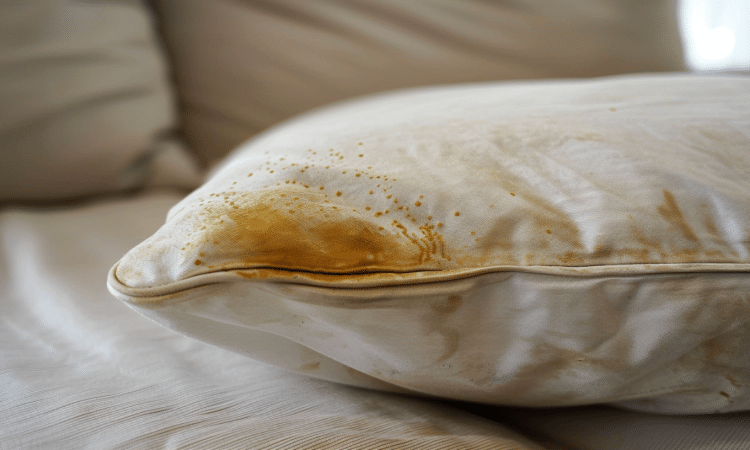
We’ve all been there! You wake up to a yellow stain on your pillow and think, “Oh no, what did I do?” The truth is, there are all kinds of things that can leave stains on your pillow while you’re sleeping. And not only do they look unattractive, but they can also be bad for your health.
People spend about a third of their day in bed – and pillows have to endure a lot. During this time, some things happen that you don’t even notice: you sweat, you lose scales of skin and hair, and sometimes your mouth leaks saliva.
All of this is perfectly normal, but it does mean that your pillows are getting dirty over time. Covers or not. In the long run, this leads to the typical yellow mold stains.
We’ll tell you what you can do about disgusting yellowed pillows and when you should replace them.
Mold Stains: Why do pillows yellow over time?
Typical mold stains appear after a pillow has been used for a long time. This is mainly due to sweat and skin oils that are released through the skin at night. However, at some point, sebum from the scalp also accumulates. Grooming products such as creams or lotions can also stain the pillow.
Therefore, taking a shower before going to bed will not help prevent mold stains. Wet or slightly damp hair can even cause harm and lead to mold growth on your pillow.
Therefore, if your pillow is already heavily soiled, it should be replaced. Otherwise, health effects such as allergic reactions or respiratory problems may occur. In addition, mites and bacteria thrive in such a humid environment.
Avoid the formation of mold stains
To prevent mold stains, you can use a waterproof pad under your pillowcase. This also alleviates allergy symptoms and is especially important for expensive pillows that you don’t want to replace every few years.
You should also change the covers regularly – experts recommend doing this weekly. However, in practice, few people have time for this. Try to find a rhythm that works for you.
When you get up in the morning, give your pillow a good airing so that moisture can escape. Vigorous shaking also helps, as this loosens the down or padding in the pillow.
Cleaning yellowed pillows and removing mold stains
For light stains, regular washing of the pillow may be enough to remove them. Follow the manufacturer’s instructions on the label – mold spores and many bacteria are killed at temperatures of 60 degrees or higher. You can also pre-treat the fabric with a spray designed to combat sweat stains.
If this does not help, you will have to resort to more aggressive methods before washing. A mixture of hydrogen peroxide and water (1:5 ratio) or vinegar and water (1:3 ratio) will help to deal with stains. Then put them in the washing machine.
The pillows must be completely dry before you can reuse them. It’s best not to leave them in direct sunlight for long, as UV rays kill germs and whiten stains.
Stale mold stains are not easy to get rid of. If you haven’t washed your pillow in a while, it may be worth buying a new one and covering it with a waterproof pillow protectant in the future.
An unsightly sight
Putting your hand on your heart, few people manage to wash all the covers every week. Nevertheless, it is advisable to clean your pillows frequently, even though yellow stains in most cases have no health implications. Nevertheless, it looks unsavory, and even a nice cover can’t hide that fact.

